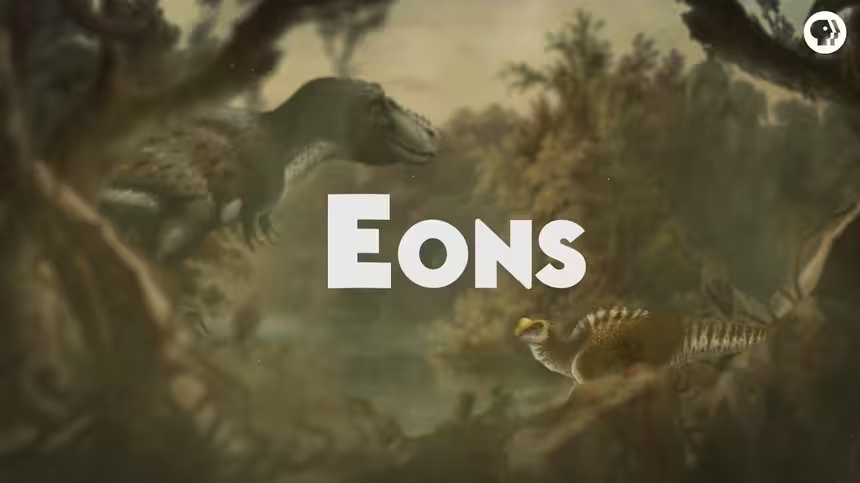
Dimetrodon: Our Most Unlikely Ancestor
Season 1 Episode 9 | 5m 21sVideo has Closed Captions
Take a close look and you might see a little bit of yourself.
With its lizard-like appearance and that distinctive sail on it back, Dimetrodon is practically the mascot of the Palaeozoic Era, a time before flowers, birds, mammals, and even crocodiles. But if you take a close look at this sail-backed animal, you might see a little bit of yourself.
Problems playing video? | Closed Captioning Feedback
Problems playing video? | Closed Captioning Feedback

Dimetrodon: Our Most Unlikely Ancestor
Season 1 Episode 9 | 5m 21sVideo has Closed Captions
With its lizard-like appearance and that distinctive sail on it back, Dimetrodon is practically the mascot of the Palaeozoic Era, a time before flowers, birds, mammals, and even crocodiles. But if you take a close look at this sail-backed animal, you might see a little bit of yourself.
Problems playing video? | Closed Captioning Feedback
How to Watch Eons
Eons is available to stream on pbs.org and the free PBS App, available on iPhone, Apple TV, Android TV, Android smartphones, Amazon Fire TV, Amazon Fire Tablet, Roku, Samsung Smart TV, and Vizio.

Welcome to Eons!
Join hosts Michelle Barboza-Ramirez, Kallie Moore, and Blake de Pastino as they take you on a journey through the history of life on Earth. From the dawn of life in the Archaean Eon through the Mesozoic Era — the so-called “Age of Dinosaurs” -- right up to the end of the most recent Ice Age.Providing Support for PBS.org
Learn Moreabout PBS online sponsorshipWhen you think about life before the dinosaurs, if anything comes to your mind at all, chances are the one animal you think of is Dimetrodon.
With its lizard-like appearance and that distinctive sail on it back, Dimetrodon is practically the mascot of the Palaeozoic Era, a time before flowers, birds, mammals, and even crocodiles.
Dimetrodon dominated the last period of the Palaeozoic, the Permian Period, alongside many other animals that can seem at once familiar and ... not.
That's because these creatures had jumbles of traits that were partly reptilian and partly mammalian, earning them the paradoxical-sounding name "mammal-like reptiles."
But these beasts don't belong on the reptile branch of the Tree of Life.
Instead you'll find them over on the mammal branch.
Because they're more accurately known as stem-mammals.
Yes, it could easily be mistaken for a primordial lizard, but Dimetrodon had a bunch of game-changing adaptations that foreshadowed the rise of mammals millions of years later.
One of its most distinctive features?
Its weird variety of teeth.
Dimetrodon's name actually means "two-measure tooth," because, before it and its kin came along, most animals had rows of teeth that were basically identical.
Meat-eaters, for example, tended to have simple, pointed teeth that all served the same function - - to pierce through meat.
But Dimetrodon had different teeth for different jobs, turning its mouth into a kind of physiological swiss army knife.
Up front, it had long, canine-like teeth for killing prey, but it also had distinct incisors and teeth in back that pointed backward, perfect for dismembering carcasses.
It was also among the earliest animals to have serrated teeth, making this stem-mammal the perfect Permian butcher, capable of devouring prey quickly and efficiently.
And having more than one kind of tooth is a hallmark of our own mammal lineage.
It eventually led to the diversity of teeth that we now find throughout the mammalian family -- from the chisel-like incisors of rodents, to the dagger-shaped canines of cats, to the grinding molars of elephants.
Before you eat your prey, though, you have to catch it.
And here, Dimetrodon had a leg up on much of its quarry.
You've probably seen pictures of Dimetrodon, and odds are those pictures showed the animal in a sprawling posture - kind of like it's doing a push up - with its belly and tail dragging on the ground.
But fossil tracks found in Oklahoma, which some experts think were made by Dimetrodon, suggest that the animal was probably capable of what's known as a high walk.
In this posture, its belly and much of its tail would have been raised off the ground, with its legs partially straight -- giving it a stance somewhere between that of a lizard and that of a mammal.
This stem-mammal strut would not only have made Dimetrodon faster and more nimble than its prey, it also would've required much less energy than the sprawling posture used by, say, amphibians.
OK. Now, I'm sure you're wondering: What was up with that sail?
For a long time, the sail of bone and skin on Dimetrodon's back was thought to be some kind of temperature regulator.
The thinking was that the sail could be turned toward the sun to absorb heat, while its large surface could release heat quickly when it was hanging out in the shade.
Some experts stick to that theory.
But in recent years, others have offered new ideas about the sail, and what it can tell us about stem-mammals.
For one thing, these researchers note, big animals retain way more heat than small animals.
So presumably, bigger Dimetrodons would need bigger sails.
But there are some relatives of Dimetrodon - - like Sphenacodon here -- that were plenty big, but had tiny sails.
Meanwhile, some smaller species had big sails - - too big to regulate heat for such small animals.
And in 2010, a study that compared Dimetrodon specimens at different ages found that its sail grew really quickly, with juveniles sprouting sails that were disproportionately large for their body size.
This suggested that, rather than serving as a solar panel, Dimetrodon may have used its sail for something even more crucial to its survival -- to communicate with others of its kind.
And here, too, mammals ended up taking a page from the book of Dimetrodon.
Lots of modern mammals, after all, are known for having flashy features, like the mane on a lion or the antlers of a deer, that advertise strength to enemies, and help attract mates.
Whether the sail of Dimetrodon was used as a mating display or for threatening rivals is anyone's guess.
But at the very least, this was one stem-mammal that had something to say to its neighbors, indicating that, as with mammals, communication was vital to its survival.
With unique teeth, extra speed, and a complex social life, Dimetrodon was able to dominate Early Permian environments.
Its success allowed it to spread to many different habitats, including swamps and deserts, from Canada to Texas to Germany.
Alas, the reign of Dimetrodon ended around 270 million years ago.
And just 20 million years later, the environmental catastrophe at end of the Permian, known as the Great Dying, spelled disaster for nearly all the stem-mammals.
But all was not lost for our mammal lineage.
The stem-mammals' ability to adapt -- which was embodied so well by Dimetrodon -- allowed some to survive.
And they went on to diversify over the next twenty million years -- evolving into a range of forms, from tiny burrowers to saber-toothed giants, and eventually, you and me.
So we can't claim Dimetrodon as our direct ancestor.
Other stem mammals have earned that title.
But still if you take a close look at this sail-backed animal, you might see a little bit of yourself.


- Science and Nature

A documentary series capturing the resilient work of female land stewards across the United States.












Support for PBS provided by:

